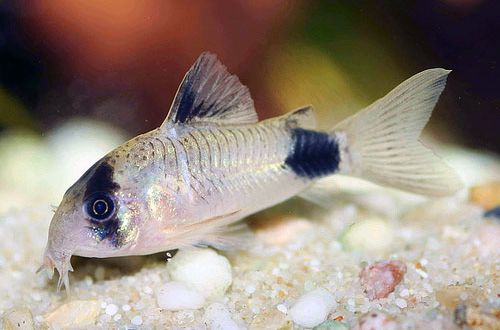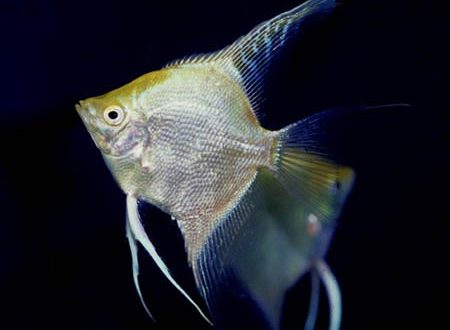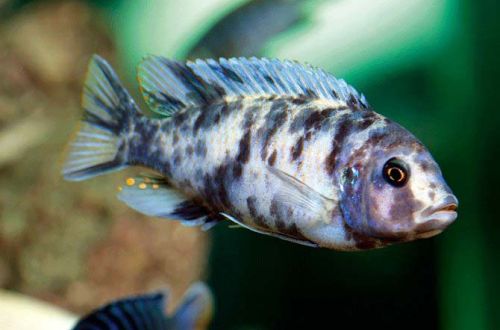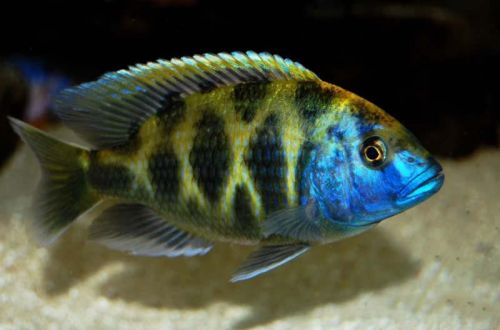
golden leopard
The golden leopard or Nimbochromis venustus, scientific name Nimbochromis venustus, belongs to the Cichlidae family. An ambush predator native to Lake Malawi in Africa that has developed a unique hunting technique. He pretends to be dead lying on the bottom near the shore or in the rocks, waiting for prey. It is worth an unsuspecting fish to be nearby, and a lightning attack will put an end to it. The hunting style is similar to that of another member of the lake with the Livingston Cichlid.

Despite its small size, the fish is popular among aquarists due to its unusual demeanor and colorful body pattern, reminiscent of the skin of a giraffe, from which it is sometimes called the Giraffe Cichlid.
Requirements and conditions:
- The volume of the aquarium – from 470 liters.
- Temperature – 23-28°C
- pH value – 7.0-8.0
- Water hardness – medium and high hardness (10–25 dH)
- Substrate type – sand or fine gravel with heaps of stones
- Lighting – moderate
- Brackish water – allowed at a concentration of 1,0002
- Water Movement – Moderate/Strong
- Size – up to 25 cm.
- Nutrition – high protein food with a small amount of herbal supplements
- Life expectancy – up to 10 years.
Habitat
Endemic to Lake Malawi, inhabiting areas along the entire coast with sandy and rocky substrates at depths of 15–20 meters, juveniles stay much higher near rocks. In nature, they feed on small fish and invertebrates.
Description
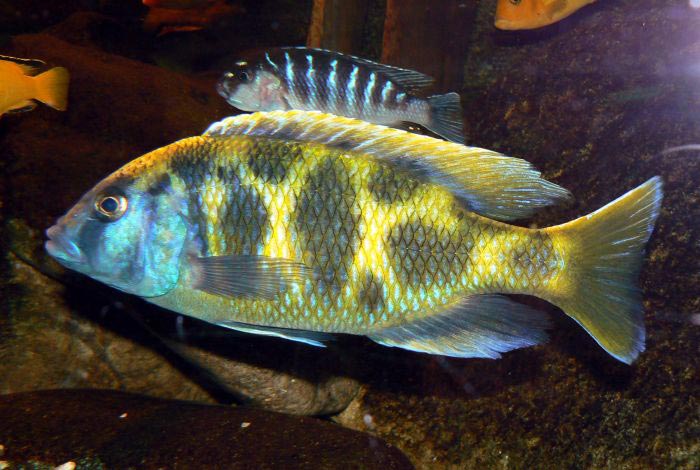
A large species of cichlid, adults reach a length of 25 cm. It has a stocky appearance with a large mouth. The coloration of males varies from golden with a blue head to completely blue all over. Giraffe pattern with characteristic large dark spots bordered by a lighter color. The coloration of females and juveniles is beige, the pattern is weakly expressed.
Food
In the wild, the Golden Leopard is a carnivore; however, it is not necessary to feed it with live fish in a home aquarium. He will gladly accept pieces of fish and shrimp meat, including after freezing. Therefore, food can be purchased in supermarkets in the fish departments. It is strongly recommended to diversify the diet with vegetable flakes for a balanced diet.
Feed 3-4 times a week with a sufficient amount of meat products comparable in volume to a small fish.
Maintenance and care
A large tank of about 500 liters will be a great home for the Golden Leopard. In the design, focus on the substrate, it should consist of coarse sand with a few scattered smooth stones. Near the side wall or as a background, place a large pile of rocks and stones. It is recommended to fasten them together with special glue to avoid destruction. The structure is installed directly on the bottom of the tank and only then it is covered with soil. The fish likes to dig in the substrate and may well dig and knock over the entire pile of stones on itself if they do not stand at the very bottom. Plants are not an obligatory design element and are placed at will. Fish may occasionally bite off the leaves of the plant, so use hard-leaved species.
Of key importance is the preparation of water, as close as possible in composition to water from Lake Malawi, which has certain parameters that are unique to it, namely, the dH index ranges from medium to high hardness, pH fluctuates around the 8.0 mark. For more information about pH and dH parameters and how to change them, see the “Hydrochemical composition of water” section.
Maintenance of the aquarium is reduced to a weekly renewal of part of the water by 10-20% with the cleaning of the soil from the waste products of fish. Installing a high-performance water treatment system will increase service intervals to two or more weeks, it all depends on financial capabilities.
The mandatory minimum set of equipment consists of a filtration system, lighting, heating and aeration. If necessary, you can add additional options to facilitate the care of the aquarium.
Behavior
Males are intolerant of each other, in a small tank (and for them 500 liters is not enough) they will arrange deadly fights. It is recommended to keep a harem when there are 3-4 females per male. He will consider the aquarium his territory, and the females his companions. It is unlikely that it will be possible to pick up neighbors, some will quickly turn into potential prey, others will become aggressors encroaching on the territory of the male.
A formed group of male / female should be acquired, the fish form a kind of family and the male may not accept other females.
Breeding
The Golden Leopard cichlid is successfully bred at home, the harem content only contributes to this. During the mating season, the male chooses a place for future action, usually a flat stone, cleared of debris, and located at a distance from strong streams. The male invites the females to his makeshift nest, where she lays 60 to 120 eggs, which she immediately takes into her mouth. This is an evolutionarily established defense mechanism that is characteristic of most cichlids. While she is collecting eggs, the male is nearby and waves his anal fin in front of her, on which there is a pattern consisting of several light dots, very similar to eggs. The female mistakenly tries to pick them up too, at which point the male releases milk and fertilization occurs.
The female carries the eggs for the entire incubation period (about 3 weeks) and, after the appearance of the fry, provides them with shelter for another 10 days. When the juveniles become free to swim throughout the aquarium, they should be relocated.
Fish diseases
In favorable conditions and a balanced diet, there are no health problems, if the necessary requirements are not met, there is a risk of an outbreak of diseases. The most common among the cichlids of Lake Malawi is the disease of the same name “Bloating Malawi”, the main reason for its occurrence is the content in inappropriate conditions. Read more about symptoms and treatments in the Aquarium Fish Diseases section.



